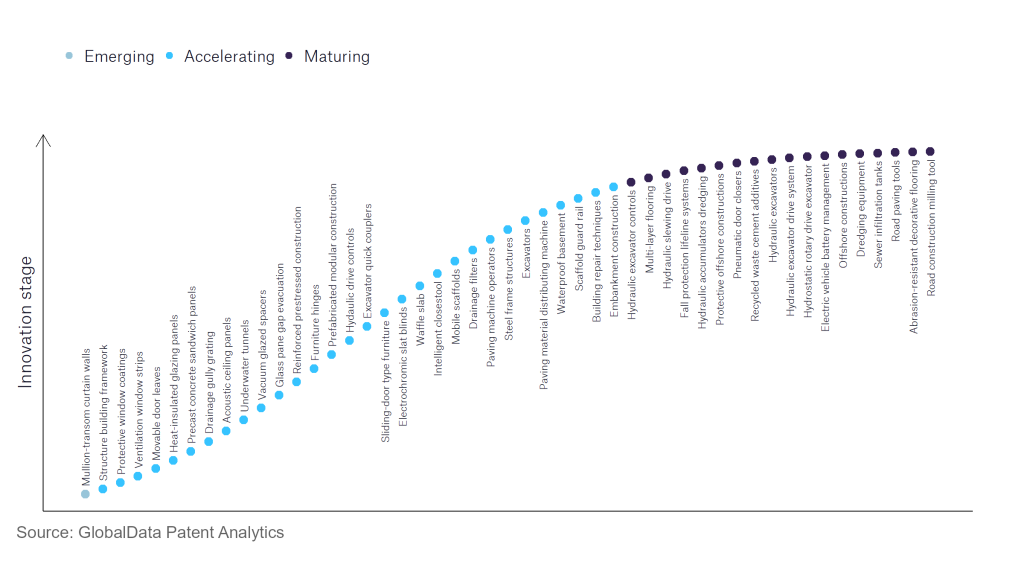The construction industry continues to be a hotbed of innovation, with activity driven by an increased focus on environmental sustainability and workplace safety, and the growing importance of technologies such as the Internet-of-Things (IoT) and robotics as well as higher quality construction products and materials. In the last three years alone, there have been over 248,000 patents filed and granted in the construction industry, according to GlobalData’s report on Innovation in Construction: Electric vehicle battery management. Buy the report here.
However, not all innovations are equal and nor do they follow a constant upward trend. Instead, their evolution takes the form of an S-shaped curve that reflects their typical lifecycle from early emergence to accelerating adoption, before finally stabilising and reaching maturity.
Identifying where a particular innovation is on this journey, especially those that are in the emerging and accelerating stages, is essential for understanding their current level of adoption and the likely future trajectory and impact they will have.
80+ innovations will shape the construction industry
According to GlobalData’s Technology Foresights, which plots the S-curve for the construction industry using innovation intensity models built on over 179,000 patents, there are 80+ innovation areas that will shape the future of the industry.
Within the emerging innovation stage, mullion-transom curtain walls are a disruptive technology that is in the early stages of application and should be tracked closely. Heat insulated glazing panels, drainage gully grating, and acoustic ceiling panels are some of the accelerating innovation areas, where adoption has been steadily increasing. Among maturing innovation areas are abrasion-resistant decorative flooring, and road construction milling tool, which are now well established in the industry.
Innovation S-curve for the construction industry

Electric vehicle battery management is a key innovation area in construction
A battery management system (BMS) monitors and manages the rechargeable battery system with the aim of ensuring
safe operation of the battery, efficient use of power and maintaining longevity. The system, for example, will prevent the battery from overcharging.
GlobalData’s analysis also uncovers the companies at the forefront of each innovation area and assesses the potential reach and impact of their patenting activity across different applications and geographies. According to GlobalData, there are 10+ companies, spanning technology vendors, established construction companies, and up-and-coming start-ups engaged in the development and application of electric vehicle battery management.
Key players in electric vehicle battery management – a disruptive innovation in the construction industry
‘Application diversity’ measures the number of different applications identified for each relevant patent and broadly splits companies into either ‘niche’ or ‘diversified’ innovators.
‘Geographic reach’ refers to the number of different countries each relevant patent is registered in and reflects the breadth of geographic application intended, ranging from ‘global’ to ‘local’.
Patent volumes related to electric vehicle battery management
| Company | Total patents (2021 - 2023) | Premium intelligence on the world's largest companies |
| Hitachi | 224 | Unlock Company Profile |
| Sumitomo Heavy Industries | 127 | Unlock Company Profile |
| Komatsu | 69 | Unlock Company Profile |
| Kobe Steel | 43 | Unlock Company Profile |
| Caterpillar | 32 | Unlock Company Profile |
| Liebherr-International | 20 | Unlock Company Profile |
| Kubota | 13 | Unlock Company Profile |
| AB Volvo | 10 | Unlock Company Profile |
| KYB | 7 | Unlock Company Profile |
| Doosan Infracore | 6 | Unlock Company Profile |
| Kohler | 5 | Unlock Company Profile |
| J C Bamford Excavators | 5 | Unlock Company Profile |
| SNCF Group | 5 | Unlock Company Profile |
| Yanmar Holdings | 5 | Unlock Company Profile |
Source: GlobalData Patent Analytics
Hitachi is the leading filer in battery management systems. The company is one of the world leaders in technical manufacturing and system management software. The majority of Hitachi’s battery management system patents used within the construction industry are used to manage the efficiency of a lithium-Ion battery in hybrid excavators. One notable patent prevents the battery from over-charging when power is re-generated by the engine. Another such patent uses a cooling system to regulate the battery temperature, with the aim of extending the batteries’ working life.
In terms of application diversity, Kubota is among the leaders in the pack, along with Liebherr-International. By means of geographic reach, KYB holds the top position, followed by Yanmar Holdings and SNCF Group.
To further understand the key themes and technologies disrupting the construction industry, access GlobalData’s latest thematic research report on Construction.
Data Insights
From

The gold standard of business intelligence.
Blending expert knowledge with cutting-edge technology, GlobalData’s unrivalled proprietary data will enable you to decode what’s happening in your market. You can make better informed decisions and gain a future-proof advantage over your competitors.



